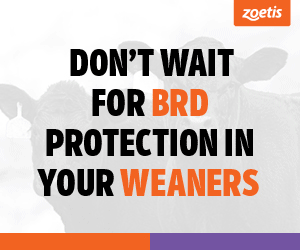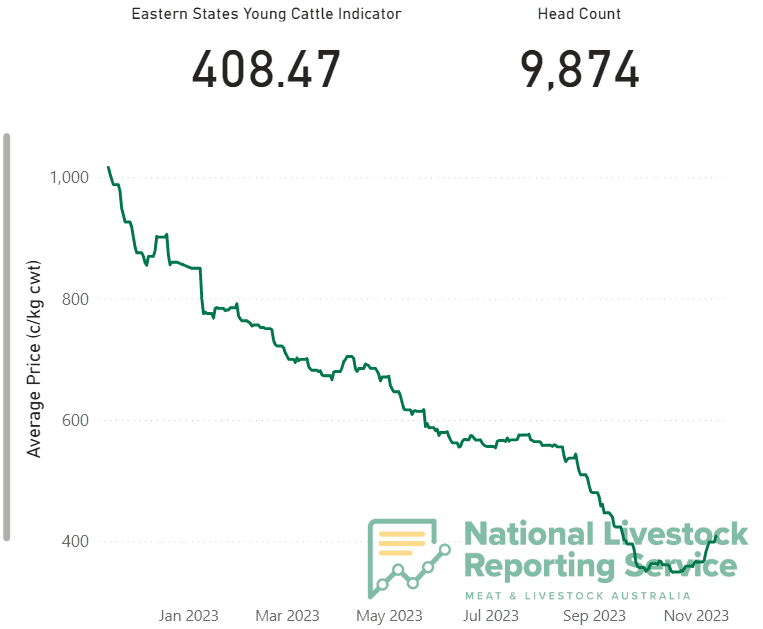CATTLE prices across the eastern states have lifted considerably in the past fortnight on the back of moderate, but widespread storm rain.
The benchmark Eastern Young Cattle Indicator has risen above 400c for the first time since September – after months of consistent downturn. It finished today at 408c/kg carcase weight, rising 40c/kg over the past seven days, and 48c higher than where it sat this time a month ago. The indicator slipped below 350c/kg for several days, from 18-20 October.
While encouraging, the recent EYCI rally remains 611c/kg behind where it sat this time last year (1016c/kg).
New South Wales has seen the biggest recent increases, with today’s Tamworth sale accounting for the highest price contribution to the EYCI, with an average of 467c and last week’s Armidale sale the next highest at 454c. Last week’s Roma and Dalby sales averaged 426c and 433c respectively.
National Livestock Reporting Service operations manager Ripley Atkinson said the biggest price increases were seen with light restocker-type cattle.
“Restockers are clearly lifting the market, they are back to paying a 28c premium over feeder cattle,” Mr Atkinson said.
 “We have immediately seen supply tighten up with a bit of rain earlier this month, and a lot of producers are now confident enough to make a play with a bit of grass in front of them towards the end of the year.”
“We have immediately seen supply tighten up with a bit of rain earlier this month, and a lot of producers are now confident enough to make a play with a bit of grass in front of them towards the end of the year.”
Large parts of NSW and Qld have sold big numbers of cattle this year with the weather drying out and forecasts of more dry weather with the formation of an El Nino.
Many say news coverage of the dry weather forecast has also spooked restocker activity this year – with many, including Beef Central Chris Howie, advising producers to have more of a focus on margins.
While most of the past fortnight’s rain fell in storms, between 20mm and 50mm, Mr Atkinson said it appeared to be enough to put some confidence back in the market.
“There has been some rain about in the past month to six weeks, but it has been localised and it hasn’t been in the widespread nature we have seen recently,” he said.
“Numbers are back significantly and I think we are seeing people extending those feed budgets out across a widespread area.”
Feeder cattle prices also on the rise
While not as significant as the lift in restocker prices, heavier feeder prices have also risen in the past fortnight, with MLA’s feeder steer indicator showing a 14c lift since the start of the month – currently sitting at 221c/kg liveweight.
Heavy feeder steers have been attracting a premium over lighter animals in recent months, with high ration costs making it cheaper for feedlots to buy kilograms than putting them on themselves. More information will come out about feedlot activity with the quarterly feedlot survey expected in the coming weeks.
“Restockers are pulling the market up, but feeders are jumping in behind them,” Mr Atkinson said.
“It has really shown how quickly the market can turn at the moment and the feedlot buyers have to up their game and compete harder for cattle.”
Are we seeing the start of rally?
Mr Atkinson said the last week has been a bit of a rally, but the situation could change with a return to adverse weather conditions.
“The confidence can be sucked out of the market with a week or 10 days of hot weather and if the tap turns off for the next couple of months there could be some trouble,” he said.
“While prices have been lower than 2019, we are certainly as badly in drought as we were back then. But it is a fickle market at the moment.”
What is the EYCI?
The Eastern Young Cattle Indicator (EYCI) is a seven-day rolling average of young cattle prices (vealer and yearling heifers and steers 200-400kg liveweight, scores C2 and C3) from 23 saleyards across Queensland, NSW and Victoria. It is expressed in c/kg carcase weight.
At any point in time, a seven-day rolling average includes data from the past seven calendar days. In the case of the EYCI, the dataset takes the average ¢/kg cwt of an animal matching the specifications of the indicator per day for the past week, adds them up and divides the figure by seven. The indicator is updated daily to create a rolling average value for this specification of animal.

